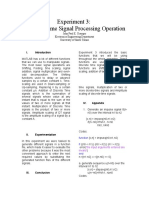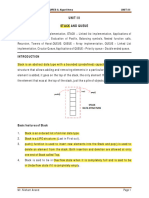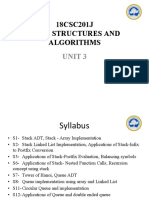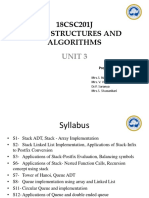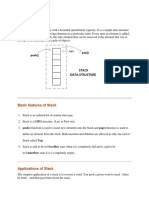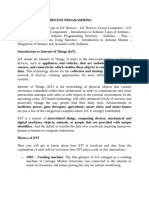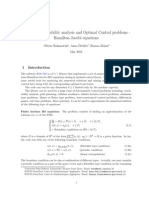Unit III
Unit III
Uploaded by
Prashant VyasCopyright:
Available Formats
Unit III
Unit III
Uploaded by
Prashant VyasOriginal Description:
Copyright
Available Formats
Share this document
Did you find this document useful?
Is this content inappropriate?
Copyright:
Available Formats
Unit III
Unit III
Uploaded by
Prashant VyasCopyright:
Available Formats
15CS201J- DATA STRUCTURES UNIT-III
UNIT III
STACK AND QUEUE
STACK: STACK – Array implementation, STACK – Linked list implementation, Applications of
STACK – Infix to Postfix, Evaluation of Postfix, Balancing symbols, Nested function calls,
Recursion, Towers of Hanoi. QUEUE: QUEUE – Array implementation, QUEUE – Linked List
implementation, Circular Queue, Applications of QUEUE – Priority queue – Double ended queue.
INTRODUCTION
Stack is an abstract data type with a bounded (predefined) capacity. It is a simple data
structure that allows adding and removing elements in a particular order. Every time an
element is added, it goes on the top of the stack, the only element that can be removed is
the element that was at the top of the stack, just like a pile of objects.
Basic features of Stack
1. Stack is an ordered list of similar data type.
2. Stack is a LIFO structure. (Last in First out).
3. push() function is used to insert new elements into the Stack and pop() is used to
delete an element from the stack. Both insertion and deletion are allowed at only
one end of Stack called Top.
4. Stack is said to be in Overflow state when it is completely full and is said to be
in Underflow state if it is completely empty.
Ms. Selva Mary. G Page 1
15CS201J- DATA STRUCTURES UNIT-III
Applications of Stack
The simplest application of a stack is to reverse a word. You push a given word to stack -
letter by letter - and then pop letters from the stack.
There are other uses also like : Parsing, Expression Conversion(Infix to Postfix, Postfix to
Prefix etc) and many more.
Implementation of Stack
Stack can be easily implemented using an Array or a Linked List. Arrays are quick, but are
limited in size and Linked List requires overhead to allocate, link, unlink, and deallocate,
but is not limited in size. Here we will implement Stack using array.
Step 1 : Declare One Stack Structure
#define size 5
struct stack
{
int s[size];
int top;
}st;
1. We have created ‘stack’ structure.
Ms. Selva Mary. G Page 2
15CS201J- DATA STRUCTURES UNIT-III
2. We have array of elements having size ‘size’
3. To keep track of Topmost element we have declared top as structure member.
Stack Using Array
A stack data structure can be implemented using one dimensional array. But stack implemented
using array, can store only fixed number of data values. This implementation is very simple, just
define a one dimensional array of specific size and insert or delete the values into that array by
using LIFO principle with the help of a variable 'top'. Initially top is set to -1. Whenever we want
to insert a value into the stack, increment the top value by one and then insert. Whenever we
want to delete a value from the stack, then delete the top value and decrement the top value by
one.
Stack Operations using Array
A stack can be implemented using array as follows...
Before implementing actual operations, first follow the below steps to create an empty stack.
Step 1: Include all the header files which are used in the program and define a
constant 'SIZE' with specific value.
Step 2: Declare all the functions used in stack implementation.
Step 3: Create a one dimensional array with fixed size (int stack[SIZE])
Step 4: Define a integer variable 'top' and initialize with '-1'. (int top = -1)
Step 5: In main method display menu with list of operations and make suitable function
calls to perform operation selected by the user on the stack.
push(value) - Inserting value into the stack
In a stack, push() is a function used to insert an element into the stack. In a stack, the new
element is always inserted at top position. Push function takes one integer value as parameter
and inserts that value into the stack. We can use the following steps to push an element on to the
stack...
Step 1: Check whether stack is FULL. (top == SIZE-1)
Step 2: If it is FULL, then display "Stack is FULL!!! Insertion is not possible!!!" and
terminate the function.
Step 3: If it is NOT FULL, then increment top value by one (top++) and set stack[top] to
value (stack[top] = value).
Ms. Selva Mary. G Page 3
15CS201J- DATA STRUCTURES UNIT-III
pop() - Delete a value from the Stack
In a stack, pop() is a function used to delete an element from the stack. In a stack, the element is
always deleted from top position. Pop function does not take any value as parameter. We can use
the following steps to pop an element from the stack...
Step 1: Check whether stack is EMPTY. (top == -1)
Step 2: If it is EMPTY, then display "Stack is EMPTY!!! Deletion is not possible!!!" and
terminate the function.
Step 3: If it is NOT EMPTY, then delete stack[top] and decrement top value by one (top--
).
display() - Displays the elements of a Stack
We can use the following steps to display the elements of a stack...
Step 1: Check whether stack is EMPTY. (top == -1)
Step 2: If it is EMPTY, then display "Stack is EMPTY!!!" and terminate the function.
Step 3: If it is NOT EMPTY, then define a variable 'i' and initialize with top.
Display stack[i] value and decrement i value by one (i--).
Step 3: Repeat above step until i value becomes '0'.
Stack using Linked List
The major problem with the stack implemented using array is, it works only for fixed number of
data values. That means the amount of data must be specified at the beginning of the
implementation itself. Stack implemented using array is not suitable, when we don't know the
size of data which we are going to use. A stack data structure can be implemented by using
linked list data structure. The stack implemented using linked list can work for unlimited
number of values. That means, stack implemented using linked list works for variable size of
data. So, there is no need to fix the size at the beginning of the implementation. The Stack
implemented using linked list can organize as many data values as we want.
In linked list implementation of a stack, every new element is inserted as 'top' element. That
means every newly inserted element is pointed by 'top'. Whenever we want to remove an
element from the stack, simply remove the node which is pointed by 'top' by moving 'top' to its
next node in the list. The next field of the first element must be always NULL.
Example
Ms. Selva Mary. G Page 4
15CS201J- DATA STRUCTURES UNIT-III
In above example, the last inserted node is 99 and the first inserted node is 25. The order of
elements inserted is 25, 32,50 and 99.
Operations
To implement stack using linked list, we need to set the following things before implementing
actual operations.
Step 1: Include all the header files which are used in the program. And declare all
the user defined functions.
Step 2: Define a 'Node' structure with two members data and next.
Step 3: Define a Node pointer 'top' and set it to NULL.
Step 4: Implement the main method by displaying Menu with list of operations and make
suitable function calls in the main method.
push(value) - Inserting an element into the Stack
We can use the following steps to insert a new node into the stack...
Step 1: Create a newNode with given value.
Step 2: Check whether stack is Empty (top == NULL)
Step 3: If it is Empty, then set newNode → next = NULL.
Step 4: If it is Not Empty, then set newNode → next = top.
Step 5: Finally, set top = newNode.
pop() - Deleting an Element from a Stack
We can use the following steps to delete a node from the stack...
Step 1: Check whether stack is Empty (top == NULL).
Ms. Selva Mary. G Page 5
15CS201J- DATA STRUCTURES UNIT-III
Step 2: If it is Empty, then display "Stack is Empty!!! Deletion is not possible!!!" and
terminate the function
Step 3: If it is Not Empty, then define a Node pointer 'temp' and set it to 'top'.
Step 4: Then set 'top = top → next'.
Step 7: Finally, delete 'temp' (free(temp)).
display() - Displaying stack of elements
We can use the following steps to display the elements (nodes) of a stack...
Step 1: Check whether stack is Empty (top == NULL).
Step 2: If it is Empty, then display 'Stack is Empty!!!' and terminate the function.
Step 3: If it is Not Empty, then define a Node pointer 'temp' and initialize with top.
Step 4: Display 'temp → data --->' and move it to the next node. Repeat the same
until temp reaches to the first node in the stack (temp → next != NULL).
Step 4: Finally! Display 'temp → data ---> NULL'.
Applications of STACK
1. Infix to Postfix
2. Evaluation of Postfix
3. Balancing symbols
4. Nested function calls
5. Recursion
6. Towers of Hanoi.
1. Infix to Postfix
The way to write arithmetic expression is known as notation. An arithmetic expression can be
written in three different but equivalent notations, i.e., without changing the essence or output
of expression. These notations are −
Infix Notation
Prefix (Polish) Notation
Postfix (Reverse-Polish) Notation
These notations are named as how they use operator in expression.
Ms. Selva Mary. G Page 6
15CS201J- DATA STRUCTURES UNIT-III
Infix Notation
We write expression in infix notation, e.g. a-b+c, where operators are used in-between
operands. It is easy for us humans to read, write and speak in infix notation but the same does
not go well with computing devices. An algorithm to process infix notation could be difficult and
costly in terms of time and space consumption.
Prefix Notation
In this notation, operator is prefixed to operands, i.e. operator is written ahead of operands. For
example +ab. This is equivalent to its infix notation a+b. Prefix notation is also known as Polish
Notation.
Postfix Notation
This notation style is known as Reversed Polish Notation. In this notation style, operator
is postfixed to the operands i.e., operator is written after the operands. For example ab+. This is
equivalent to its infix notation a+b.
Algorithm for Infix to Postfix
1. Examine the next element in the input.
2. If it is operand, output it.
3. If it is opening parenthesis, push it on stack.
4. If it is an operator, then
If stack is empty, push operator on stack.
If the top of stack is opening parenthesis, push operator on stack
If it has higher priority than the top of stack, push operator on stack.
Else pop the operator from the stack and output it, repeat step 4
5. If it is a closing parenthesis, pop operators from stack and output them until an
opening parenthesis is encountered. pop and discard the opening parenthesis.
6. If there is more input go to step 1
7. If there is no more input, pop the remaining operators to output.
Ms. Selva Mary. G Page 7
15CS201J- DATA STRUCTURES UNIT-III
Example
Consider the following Infix Expression to be converted into Postfix Expression...
D=A+B*C
Step 1: The Operators in the given Infix Expression : = , + , *
Step 2: The Order of Operators according to their preference : * , + , =
Step 3: Now, convert the first operator * ----- D = A + B C *
Step 4: Convert the next operator + ----- D = A BC* +
Step 5: Convert the next operator = ----- D ABC*+ =
Finally, given Infix Expression is converted into Postfix Expression as follows...
DABC*+=
Example
Consider the following Infix Expression...
(A+B)*(C-D)
The given infix expression can be converted into postfix expression using Stack
data Structure as follows...
Ms. Selva Mary. G Page 8
15CS201J- DATA STRUCTURES UNIT-III
The final Postfix Expression is as follows...
AB+CD-*
Ms. Selva Mary. G Page 9
15CS201J- DATA STRUCTURES UNIT-III
1. Evaluation of Postfix
A postfix expression is a collection of operators and operands in which the operator is
placed after the operands. That means, in a postfix expression the operator follows the
operands.
Postfix Expression has following general structure...
Operand1 Operand2 Operator
Example
Postfix Expression Evaluation using Stack Data Structure
A postfix expression can be evaluated using the Stack data structure. To evaluate a postfix
expression using Stack data structure we can use the following steps...
1. Read all the symbols one by one from left to right in the given Postfix
Expression
2. If the reading symbol is operand, then push it on to the Stack.
3. If the reading symbol is operator (+ , - , * , / etc.,), then perform TWO pop
operations and store the two popped oparands in two different variables
(operand1 and operand2). Then perform reading symbol operation using
operand1 and operand2 and push result back on to the Stack.
4. Finally! Perform a pop operation and display the popped value as final result.
Example
Consider the following Expression...
Ms. Selva Mary. G Page 10
15CS201J- DATA STRUCTURES UNIT-III
Ms. Selva Mary. G Page 11
15CS201J- DATA STRUCTURES UNIT-III
Ms. Selva Mary. G Page 12
15CS201J- DATA STRUCTURES UNIT-III
Example:
Let the given expression be “2 3 1 * + 9 -“. We scan all elements one by one.
1) Scan ‘2’, it’s a number, so push it to stack. Stack contains ‘2’
2) Scan ‘3’, again a number, push it to stack, stack now contains ‘2 3′ (from bottom to top)
3) Scan ‘1’, again a number, push it to stack, stack now contains ‘2 3 1′
4) Scan ‘*’, it’s an operator, pop two operands from stack, apply the * operator on
operands, we get 3*1 which results in 3. We push the result ‘3’ to stack. Stack now
becomes ‘2 3′.
5) Scan ‘+’, it’s an operator, pop two operands from stack, apply the + operator on
operands, we get 3 + 2 which results in 5. We push the result ‘5’ to stack. Stack now
becomes ‘5’.
6) Scan ‘9’, it’s a number, we push it to the stack. Stack now becomes ‘5 9′.
7) Scan ‘-‘, it’s an operator, pop two operands from stack, apply the – operator on
operands, we get 5 – 9 which results in -4. We push the result ‘-4′ to stack. Stack now
becomes ‘-4′.
8) There are no more elements to scan, we return the top element from stack (which is
the only element left in stack)
2. Balancing Symbols
This program uses stack to check balanced expression. The expression is parsed
character by character and when opening bracket is found, it is inserted into stack. When
the equivalent closing bracket is found, the stack is emptied. If the stack is empty after
parsing the entire expression, then the expression is balanced expression.
Algorithm:
1. Whenever we see a opening parenthesis, we put it on stack.
2. For closing parenthesis, check what is at the top of the stack, if it corresponding
opening parenthesis, remove it from the top of the stack.
Ms. Selva Mary. G Page 13
15CS201J- DATA STRUCTURES UNIT-III
3. If parenthesis at the top of the stack is not corresponding opening parenthesis, return
false, as there is no point check the string further.
4. After processing entire string, check if stack is empty or not.
4.a If the stack is empty, return true.
4.b If stack is not empty, parenthesis do not match.
Example
(()(( )))
Input Input Operation Stack Symbol
(()(( ))) ( PUSH (
()(( ))) ( PUSH ((
)(( ))) ) POP (
(( ))) ( PUSH ((
( ))) ( PUSH (((
))) ) POP ((
)) ) POP (
) ) POP Empty (Accepted)
3. Recursion
Many programming languages implement recursion by means of stacks. Generally,
whenever a function (caller) calls another function (callee) or itself as callee, the caller
function transfers execution control to callee. This transfer process may also involve
some data to be passed from caller to callee.
This implies, the caller function has to suspend its execution temporarily and resume
later when the execution control returns from callee function. Here, caller function
needs to start exactly from the point of execution where it put itself on hold. It also
Ms. Selva Mary. G Page 14
15CS201J- DATA STRUCTURES UNIT-III
needs the exact same data values it was working on. For this purpose an activation
record (or stack frame) is created for caller function.
This activation record keeps the information about local variables, formal parameters,
return address and all information passed to called function.
4. Towers of Hanoi
Tower of Hanoi, is a mathematical puzzle which consists of three tower (pegs)
and more than one rings; as depicted below −
These rings are of different sizes and stacked upon in ascending order i.e. the
smaller one sits over the larger one. There are other variations of puzzle where
the number of disks increase, but the tower count remains the same.
Ms. Selva Mary. G Page 15
15CS201J- DATA STRUCTURES UNIT-III
Rules
The mission is to move all the disks to some another tower without violating the
sequence of arrangement. The below mentioned are few rules which are to be followed
for tower of hanoi −
Only one disk can be moved among the towers at any given time.
Only the "top" disk can be removed.
No large disk can sit over a small disk.
Here is an animated representation of solving a tower of hanoi puzzle with three disks −
Tower of hanoi puzzle with n disks can be solved in minimum 2n−1 steps. This
presentation shows that a puzzle with 3 disks has taken 23−1 = 7 steps.
Algorithm
To write an algorithm for Tower of Hanoi, first we need to learn how to solve this
problem with lesser amount of disks, say → 1 or 2. We mark three towers with
name, source, destination and aux (only to help moving disks). If we have only one disk,
then it can easily be moved from source to destination peg.
If we have 2 disks −
First we move the smaller one (top) disk to aux peg
Then we move the larger one (bottom) disk to destination peg
And finally, we move the smaller one from aux to destination peg.
Ms. Selva Mary. G Page 16
15CS201J- DATA STRUCTURES UNIT-III
So now we are in a position to design algorithm for Tower of Hanoi with more than two
disks. We divide the stack of disks in two parts. The largest disk (n thdisk) is in one part
and all other (n-1) disks are in second part.
Our ultimate aim is to move disk n from source to destination and then put all other (n-
1) disks onto it. Now we can imagine to apply the same in recursive way for all given set
of disks. So steps to follow are −
Step 1 − Move n-1 disks from source to aux
Step 2 − Move nth disk from source to dest
Step 3 − Move n-1 disks from aux to dest
A recursive algorithm for Tower of Hanoi can be driven as follows −
START
Procedure Hanoi(disk, source, dest, aux)
IF disk == 0, THEN
move disk from source to dest
ELSE
Hanoi(disk - 1, source, aux, dest) // Step 1
move disk from source to dest // Step 2
Hanoi(disk - 1, aux, dest, source) // Step 3
END IF
END Procedure
STOP
Ms. Selva Mary. G Page 17
15CS201J- DATA STRUCTURES UNIT-III
QUEUE
Queue is a linear data structure in which the insertion and deletion operations are
performed at two different ends. In a queue data structure, adding and removing of
elements are performed at two different positions. The insertion is performed at one end
and deletion is performed at other end. In a queue data structure, the insertion operation
is performed at a position which is known as 'rear' and the deletion operation is
performed at a position which is known as 'front'. In queue data structure, the insertion
and deletion operations are performed based on FIFO (First In First Out) principle.
In a queue data structure, the insertion operation is performed using a function called
"enQueue()" and deletion operation is performed using a function called "deQueue()".
Queue data structure can be defined as follows...
Queue data structure is a linear data structure in which the operations are
performed based on FIFO principle.
A queue can also be defined as
"Queue data structure is a collection of similar data items in which insertion and
deletion operations are performed based on FIFO principle".
Example
Queue after inserting 25, 30, 51, 60 and 85.
Ms. Selva Mary. G Page 18
15CS201J- DATA STRUCTURES UNIT-III
Operations on a Queue
The following operations are performed on a queue data structure...
1. enQueue(value) - (To insert an element into the queue)
2. deQueue() - (To delete an element from the queue)
3. display() - (To display the elements of the queue)
Queue data structure can be implemented in two ways. They are as follows...
1. Using Array
2. Using Linked List
When a queue is implemented using array, that queue can organize only limited number
of elements. When a queue is implemented using linked list, that queue can organize
unlimited number of elements.
Applications of Queue:
Queue is used when things don’t have to be processed immediatly, but have to be
processed in First InFirst Out order like Breadth First Search. This property of Queue
makes it also useful in following kind of scenarios.
1) When a resource is shared among multiple consumers. Examples include CPU
scheduling, Disk Scheduling.
2) When data is transferred asynchronously (data not necessarily received at same rate
as sent) between two processes. Examples include IO Buffers, pipes, file IO, etc.
Array implementation Of Queue
Queue Using Array
A queue data structure can be implemented using one dimensional array. But, queue
implemented using array can store only fixed number of data values. The implementation
of queue data structure using array is very simple, just define a one dimensional array of
Ms. Selva Mary. G Page 19
15CS201J- DATA STRUCTURES UNIT-III
specific size and insert or delete the values into that array by using FIFO (First In First
Out) principle with the help of variables 'front' and 'rear'. Initially both 'front' and
'rear' are set to -1. Whenever, we want to insert a new value into the queue, increment
'rear' value by one and then insert at that position. Whenever we want to delete a value
from the queue, then increment 'front' value by one and then display the value at 'front'
position as deleted element.
Queue Operations using Array
Queue data structure using array can be implemented as follows...
Before we implement actual operations, first follow the below steps to create an empty
queue.
Step 1: Include all the header files which are used in the program and define a
constant 'SIZE' with specific value.
Step 2: Declare all the user defined functions which are used in queue
implementation.
Step 3: Create a one dimensional array with above defined SIZE (int queue[SIZE])
Step 4: Define two integer variables 'front' and 'rear' and initialize both with '-1'.
(int front = -1, rear = -1)
Step 5: Then implement main method by displaying menu of operations list and
make suitable function calls to perform operation selected by the user on queue.
enQueue(value) - Inserting value into the queue
In a queue data structure, enQueue() is a function used to insert a new element into the
queue. In a queue, the new element is always inserted at rear position. The enQueue()
function takes one integer value as parameter and inserts that value into the queue.
Step 1: Check whether queue is FULL. (rear == SIZE-1)
Ms. Selva Mary. G Page 20
15CS201J- DATA STRUCTURES UNIT-III
Step 2: If it is FULL, then display "Queue is FULL!!! Insertion is not
possible!!!" and terminate the function.
Step 3: If it is NOT FULL, then increment rear value by one (rear++) and
set queue[rear] = value.
deQueue() - Deleting a value from the Queue
In a queue data structure, deQueue() is a function used to delete an element from the
queue. In a queue, the element is always deleted from front position. The deQueue()
function does not take any value as parameter. We can use the following steps
Step 1: Check whether queue is EMPTY. (front == rear)
Step 2: If it is EMPTY, then display "Queue is EMPTY!!! Deletion is not
possible!!!" and terminate the function.
Step 3: If it is NOT EMPTY, then increment the front value by one (front ++).
Then display queue[front] as deleted element. Then check whether
both front and rear are equal (front == rear), if it TRUE, then set
both front and rear to '-1' (front = rear = -1).
display() - Displays the elements of a Queue
Step 1: Check whether queue is EMPTY. (front == rear)
Step 2: If it is EMPTY, then display "Queue is EMPTY!!!" and terminate the
function.
Step 3: If it is NOT EMPTY, then define an integer variable 'i' and set 'i = front+1'.
Step 3: Display 'queue[i]' value and increment 'i' value by one (i++). Repeat the
same until 'i' value is equal to rear (i <= rear)
Ms. Selva Mary. G Page 21
15CS201J- DATA STRUCTURES UNIT-III
Linked List implementation Of Queue
Queue using Linked List
The major problem with the queue implemented using array is, It will work for only fixed
number of data. That means, the amount of data must be specified in the beginning itself.
Queue using array is not suitable when we don't know the size of data which we are
going to use. A queue data structure can be implemented using linked list data structure.
The queue which is implemented using linked list can work for unlimited number of
values. That means, queue using linked list can work for variable size of data (No need to
fix the size at beginning of the implementation). The Queue implemented using linked list
can organize as many data values as we want.
In linked list implementation of a queue, the last inserted node is always pointed by
'rear' and the first node is always pointed by 'front'.
Example
In above example, the last inserted node is 50 and it is pointed by 'rear' and the first
inserted node is 10 and it is pointed by 'front'. The order of elements inserted is 10, 15,
22 and 50.
Operations
To implement queue using linked list, we need to set the following things before
implementing actual operations.
Step 1: Include all the header files which are used in the program. And declare all
the user defined functions.
Step 2: Define a 'Node' structure with two members data and next.
Ms. Selva Mary. G Page 22
15CS201J- DATA STRUCTURES UNIT-III
Step 3: Define two Node pointers 'front' and 'rear' and set both to NULL.
Step 4: Implement the main method by displaying Menu of list of operations and
make suitable function calls in the main method to perform user selected
operation.
enQueue(value) - Inserting an element into the Queue
We can use the following steps to insert a new node into the queue...
Step 1: Create a newNode with given value and set 'newNode → next' to NULL.
Step 2: Check whether queue is Empty (rear == NULL)
Step 3: If it is Empty then, set front = newNode and rear = newNode.
Step 4: If it is Not Empty then, set rear → next = newNode and rear = newNode.
deQueue() - Deleting an Element from Queue
We can use the following steps to delete a node from the queue...
Step 1: Check whether queue is Empty (front == NULL).
Step 2: If it is Empty, then display "Queue is Empty!!! Deletion is not
possible!!!" and terminate from the function
Step 3: If it is Not Empty then, define a Node pointer 'temp' and set it to 'front'.
Step 4: Then set 'front = front → next' and delete 'temp' (free(temp)).
display() - Displaying the elements of Queue
We can use the following steps to display the elements (nodes) of a queue...
Step 1: Check whether queue is Empty (front == NULL).
Step 2: If it is Empty then, display 'Queue is Empty!!!' and terminate the function.
Ms. Selva Mary. G Page 23
15CS201J- DATA STRUCTURES UNIT-III
Step 3: If it is Not Empty then, define a Node pointer 'temp' and initialize
with front.
Step 4: Display 'temp → data --->' and move it to the next node. Repeat the same
until 'temp' reaches to 'rear' (temp → next !=NULL).
Step 4: Finally! Display 'temp → data ---> NULL'.
Circular Queue
In a standard queue data structure re-buffering problem occurs for each dequeue
operation. To solve this problem by joining the front and rear ends of a queue to make
the queue as a circular queue. Circular queue is a linear data structure. It follows FIFO
principle.
In circular queue the last node is connected back to the first node to make a circle.
Circular linked list fallow the First In First Out principle
Elements are added at the rear end and the elements are deleted at front end of
the queue
Both the front and the rear pointers points to the beginning of the array.
It is also called as “Ring buffer”.
Items can inserted and deleted from a queue in O(1) time.
Circular Queue can be created in three ways they are
· Using single linked list
· Using double linked list
· Using arrays
Ms. Selva Mary. G Page 24
15CS201J- DATA STRUCTURES UNIT-III
In a normal Queue Data Structure, we can insert elements until queue becomes full. But
once if queue becomes full, we can not insert the next element until all the elements are
deleted from the queue. For example consider the queue below...
After inserting all the elements into the queue.
Now consider the following situation after deleting three elements from the queue...
This situation also says that Queue is Full and we can not insert the new element because,
'rear' is still at last position. In above situation, even though we have empty positions in
the queue we can not make use of them to insert new element. This is the major problem
in normal queue data structure. To overcome this problem we use circular queue data
structure.
A Circular Queue can be defined as follows...
Circular Queue is a linear data structure in which the operations are performed based on
FIFO (First In First Out) principle and the last position is connected back to the first
position to make a circle.
Graphical representation of a circular queue is as follows...
Ms. Selva Mary. G Page 25
15CS201J- DATA STRUCTURES UNIT-III
Implementation of Circular Queue
To implement a circular queue data structure using array, we first perform the following
steps before we implement actual operations.
Step 1: Include all the header files which are used in the program and define a
constant 'SIZE' with specific value.
Step 2: Declare all user defined functions used in circular queue implementation.
Step 3: Create a one dimensional array with above defined SIZE (int cQueue[SIZE])
Step 4: Define two integer variables 'front' and 'rear' and initialize both with '-1'.
(int front = -1, rear = -1)
Step 5: Implement main method by displaying menu of operations list and make
suitable function calls to perform operation selected by the user on circular queue.
enQueue(value) - Inserting value into the Circular Queue
In a circular queue, enQueue() is a function which is used to insert an element into the
circular queue. In a circular queue, the new element is always inserted at rear position.
The enQueue() function takes one integer value as parameter and inserts that value into
the circular queue. We can use the following steps to insert an element into the circular
queue...
Step 1: Check whether queue is FULL. ((rear == SIZE-1 && front == 0) || (front ==
rear+1))
Step 2: If it is FULL, then display "Queue is FULL!!! Insertion is not possible!!!" and
terminate the function.
Step 3: If it is NOT FULL, then check rear == SIZE - 1 && front != 0 if it is TRUE, then
set rear = -1.
Step 4: Increment rear value by one (rear++), set queue[rear] = value and check
'front == -1' if it is TRUE, then set front = 0.
deQueue() - Deleting a value from the Circular Queue
In a circular queue, deQueue() is a function used to delete an element from the circular
queue. In a circular queue, the element is always deleted from front position. The
Ms. Selva Mary. G Page 26
15CS201J- DATA STRUCTURES UNIT-III
deQueue() function doesn't take any value as parameter. We can use the following steps
to delete an element from the circular queue...
Step 1: Check whether queue is EMPTY. (front == -1 && rear == -1)
Step 2: If it is EMPTY, then display "Queue is EMPTY!!! Deletion is not
possible!!!" and terminate the function.
Step 3: If it is NOT EMPTY, then display queue[front] as deleted element and
increment the front value by one (front ++). Then check whether front == SIZE, if it
is TRUE, then set front = 0. Then check whether both front - 1 and rear are equal
(front -1 ==rear), if it TRUE, then set both front and rear to '-1' (front = rear = -1).
display() - Displays the elements of a Circular Queue
We can use the following steps to display the elements of a circular queue...
Step 1: Check whether queue is EMPTY. (front == -1)
Step 2: If it is EMPTY, then display "Queue is EMPTY!!!" and terminate the function.
Step 3: If it is NOT EMPTY, then define an integer variable 'i' and set 'i = front'.
Step 4: Check whether 'front <= rear', if it is TRUE, then display 'queue[i]' value
and increment 'i' value by one (i++). Repeat the same until 'i <= rear'
becomes FALSE.
Step 5: If 'front <= rear' is FALSE, then display 'queue[i]' value and increment 'i'
value by one (i++). Repeat the same until'i <= SIZE - 1' becomes FALSE.
Step 6: Set i to 0.
Step 7: Again display 'cQueue[i]' value and increment i value by one (i++). Repeat
the same until 'i <= rear' becomes FALSE.
Ms. Selva Mary. G Page 27
15CS201J- DATA STRUCTURES UNIT-III
Applications of QUEUE
1. Priority queue
2. Double ended queue.
Priority Queue
In normal queue data structure, insertion is performed at the end of the queue and
deletion is performed based on the FIFO principle. This queue implementation may not
be suitable for all situations.
Consider a networking application where server has to respond for requests from
multiple clients using queue data structure. Assume four requests arrived to the queue in
the order of R1 requires 20 units of time, R2 requires 2 units of time, R3 requires 10 units
of time and R4 requires 5 units of time. Queue is as follows...
Now, check waiting time for each request to be complete.
1. R1 : 20 units of time
2. R2 : 22 units of time (R2 must wait till R1 complete - 20 units and R2 itself
requeres 2 units. Total 22 units)
3. R3 : 32 units of time (R3 must wait till R2 complete - 22 units and R3 itself
requeres 10 units. Total 32 units)
4. R4 : 37 units of time (R4 must wait till R3 complete - 35 units and R4 itself
requeres 5 units. Total 37 units)
Here, average waiting time for all requests (R1, R2, R3 and R4) is (20+22+32+37)/4 ≈ 27
units of time.
That means, if we use a normal queue data structure to serve these requests the average
waiting time for each request is 27 units of time.
Ms. Selva Mary. G Page 28
15CS201J- DATA STRUCTURES UNIT-III
Now, consider another way of serving these requests. If we serve according to their
required amount of time. That means, first we serve R2 which has minimum time
required (2) then serve R4 which has second minimum time required (5) then serve R3
which has third minimum time required (10) and finnaly R1 which has maximum time
required (20).
Now, check waiting time for each request to be complete.
1. R2 : 2 units of time
2. R4 : 7 units of time (R4 must wait till R2 complete 2 units and R4 itself requeres 5
units. Total 7 units)
3. R3 : 17 units of time (R3 must wait till R4 complete 7 units and R3 itself requeres
10 units. Total 17 units)
4. R1 : 37 units of time (R1 must wait till R3 complete 17 units and R1 itself requeres
20 units. Total 37 units)
Here, average waiting time for all requests (R1, R2, R3 and R4) is (2+7+17+37)/4 ≈ 15
units of time.
From above two situations, it is very clear that, by using second method server can
complete all four requests with very less time compared to the first method. This is what
exactly done by the priority queue.
Priority queue is a variant of queue data structure in which insertion is performed in the
order of arrival and deletion is performed based on the priority.
There are two types of priority queues they are as follows...
1. Max Priority Queue
2. Min Priority Queuerity Queue
Ms. Selva Mary. G Page 29
15CS201J- DATA STRUCTURES UNIT-III
In max priority queue, elements are inserted in the order in which they arrive the
queue and always maximum value is removed first from the queue. For example
assume that we insert in order 8, 3, 2, 5 and they are removed in the order 8, 5, 3, 2.
Priority Queue is an extension of queue with following properties.
1) Every item has a priority associated with it.
2) An element with high priority is dequeued before an element with low priority.
3) If two elements have the same priority, they are served according to their order in the
queue.
The following are the operations performed in a Max priority queue...
1. isEmpty() - Check whether queue is Empty.
2. insert() - Inserts a new value into the queue.
3. findMax() - Find maximum value in the queue.
4. remove() - Delete maximum value from the queue.
Max Priority Queue Representations
There are 6 representations of max priority queue.
1. Using an Unordered Array (Dynamic Array)
2. Using an Unordered Array (Dynamic Array) with the index of the maximum value
3. Using an Array (Dynamic Array) in Decreasing Order
4. Using an Array (Dynamic Array) in Increasing Order
5. Using Linked List in Increasing Order
6. Using Unordered Linked List with reference to node with the maximum value
Ms. Selva Mary. G Page 30
15CS201J- DATA STRUCTURES UNIT-III
#1. Using an Unordered Array (Dynamic Array)
In this representation elements are inserted according to their arrival order and
maximum element is deleted first from max priority queue.
For example, assume that elements are inserted in the order of 8, 2, 3 and 5. And they are
removed in the order 8, 5, 3 and 2.
Now, let us analyse each operation according to this representation...
isEmpty() - If 'front == -1' queue is Empty. This operation requires O(1) time
complexity that means constant time.
insert() - New element is added at the end of the queue. This operation requires
O(1) time complexity that means constant time.
findMax() - To find maximum element in the queue, we need to compare with all
the elements in the queue. This operation requires O(n)time complexity.
remove() - To remove an element from the queue first we need to perform
findMax() which requires O(n) and removal of particular element requires
constant time O(1). This operation requires O(n) time complexity.
#2. Using an Unordered Array (Dynamic Array) with the index of the maximum
value
In this representation elements are inserted according to their arrival order and
maximum element is deleted first from max priority queue.
For example, assume that elements are inserted in the order of 8, 2, 3 and 5. And they are
removed in the order 8, 5, 3 and 2.
Ms. Selva Mary. G Page 31
15CS201J- DATA STRUCTURES UNIT-III
Now, let us analyse each operation according to this representation...
isEmpty() - If 'front == -1' queue is Empty. This operation requires O(1) time
complexity that means constant time.
insert() - New element is added at the end of the queue with O(1) and for each
insertion we need to update maxIndex with O(1). This operation requires O(1)
time complexity that means constant time.
findMax() - To find maximum element in the queue is very simple as maxIndex has
maximum element index. This operation requires O(1)time complexity.
remove() - To remove an element from the queue first we need to perform
findMax() which requires O(1) , removal of particular element requires constant
time O(1) and update maxIndex value which requires O(n). This operation
requires O(n) time complexity.
#3. Using an Array (Dynamic Array) in Decreasing Order
In this representation elements are inserted according to their value in decreasing order
and maximum element is deleted first from max priority queue.
For example, assume that elements are inserted in the order of 8, 5, 3 and 2. And they are
removed in the order 8, 5, 3 and 2.
Ms. Selva Mary. G Page 32
15CS201J- DATA STRUCTURES UNIT-III
Now, let us analyse each operation according to this representation...
isEmpty() - If 'front == -1' queue is Empty. This operation requires O(1) time
complexity that means constant time.
insert() - New element is added at a particular position in the decreasing order
into the queue with O(n), because we need to shift existing elements inorder to
insert new element in decreasing order. This operation requires O(n) time
complexity.
findMax() - To find maximum element in the queue is very simple as maximum
element is at the beginning of the queue. This operation requires O(1) time
complexity.
remove() - To remove an element from the queue first we need to perform
findMax() which requires O(1), removal of particular element requires constant
time O(1) and rearrange remaining elements which requires O(n). This operation
requires O(n) time complexity.
#4. Using an Array (Dynamic Array) in Increasing Order
In this representation elements are inserted according to their value in increasing order
and maximum element is deleted first from max priority queue.
For example, assume that elements are inserted in the order of 2, 3, 5 and 8. And they are
removed in the order 8, 5, 3 and 2.
Now, let us analyse each operation according to this representation...
isEmpty() - If 'front == -1' queue is Empty. This operation requires O(1) time
complexity that means constant time.
Ms. Selva Mary. G Page 33
15CS201J- DATA STRUCTURES UNIT-III
insert() - New element is added at a particular position in the increasing order into
the queue with O(n), because we need to shift existing elements inorder to insert
new element in increasing order. This operation requires O(n) time complexity.
findMax() - To find maximum element in the queue is very simple as maximum
element is at the end of the queue. This operation requiresO(1) time complexity.
remove() - To remove an element from the queue first we need to perform
findMax() which requires O(1), removal of particular element requires constant
time O(1) and rearrange remaining elements which requires O(n). This operation
requires O(n) time complexity.
#5. Using Linked List in Increasing Order
In this representation, we use a single linked list to represent max priority queue. In this
representation elements are inserted according to their value in increasing order and
node with maximum value is deleted first from max priority queue.
For example, assume that elements are inserted in the order of 2, 3, 5 and 8. And they are
removed in the order 8, 5, 3 and 2.
Now, let us analyse each operation according to this representation...
isEmpty() - If 'head == NULL' queue is Empty. This operation requires O(1) time
complexity that means constant time.
insert() - New element is added at a particular position in the increasing order into
the queue with O(n), because we need to the position where new element has to be
inserted. This operation requires O(n) time complexity.
findMax() - To find maximum element in the queue is very simple as maximum
element is at the end of the queue. This operation requiresO(1) time complexity.
Ms. Selva Mary. G Page 34
15CS201J- DATA STRUCTURES UNIT-III
remove() - To remove an element from the queue is simply removing the last node
in the queue which requires O(1). This operation requires O(1) time complexity.
#6. Using Unordered Linked List with reference to node with the maximum value
In this representation, we use a single linked list to represent max priority queue. Always
we maitain a reference (maxValue) to the node with maximum value. In this
representation elements are inserted according to their arrival and node with maximum
value is deleted first from max priority queue.
For example, assume that elements are inserted in the order of 2, 8, 3 and 5. And they are
removed in the order 8, 5, 3 and 2.
Now, let us analyse each operation according to this representation...
isEmpty() - If 'head == NULL' queue is Empty. This operation requires O(1) time
complexity that means constant time.
insert() - New element is added at end the queue with O(1) and update maxValue
reference with O(1). This operation requires O(1) time complexity.
findMax() - To find maximum element in the queue is very simple as maxValue is
referenced to the node with maximum value in the queue. This operation requires
O(1) time complexity.
remove() - To remove an element from the queue is deleting the node which
referenced by maxValue which requires O(1) and update maxValue reference to
new node with maximum value in the queue which requires O(n) time complexity.
This operation requires O(n)time complexity.
Ms. Selva Mary. G Page 35
15CS201J- DATA STRUCTURES UNIT-III
2. Min Priority Queue Representations
Min Priority Queue is similar to max priority queue except removing maximum element
first, we remove minimum element first in min priority queue.
The following operations are performed in Min Priority Queue...
1. isEmpty() - Check whether queue is Empty.
2. insert() - Inserts a new value into the queue.
3. findMin() - Find minimum value in the queue.
4. remove() - Delete minimum value from the queue.
Min priority queue is also has same representations as Max priority queue with minimum
value removal.
Applications of Priority Queue:
1) CPU Scheduling
2) Graph algorithms like Dijkstra’s shortest path algorithm, Prim’s
Minimum Spanning Tree, etc
3) All queue applications where priority is involved.
Double ended Queue or Dequeue
Double Ended Queue is also a Queue data structure in which the insertion and deletion
operations are performed at both the ends (frontand rear). That means, we can insert at
both front and rear positions and can delete from both front and rear positions.
Double Ended Queue can be represented in TWO ways, those are as follows...
1. Input Restricted Double Ended Queue
2. Output Restricted Double Ended Queue
Ms. Selva Mary. G Page 36
15CS201J- DATA STRUCTURES UNIT-III
Input Restricted Double Ended Queue
In input restricted double ended queue, the insertion operation is performed at only one
end and deletion operation is performed at both the ends.
Output Restricted Double Ended Queue
In output restricted double ended queue, the deletion operation is performed at only one
end and insertion operation is performed at both the ends.
Applications of Dequeue:
Since Dequeue supports both stack and queue operations, it can be used as both. The
Dequeue data structure supports clockwise and anticlockwise rotations in O(1) time
which can be useful in certain applications.
Also, the problems where elements need to be removed and or added both ends can be
efficiently solved using Dequeue. For example see Maximum of all subarrays of size k
problem..
Another example of A-Steal job scheduling algorithm where Deque is used as deletions
operation is required at both ends.
Ms. Selva Mary. G Page 37
You might also like
- Experiment 3Document4 pagesExperiment 3Anonymous 5YbFQnHNo ratings yet
- Lab-15 Shell Scripting Lab Assignment 2-4Document8 pagesLab-15 Shell Scripting Lab Assignment 2-4philysworldNo ratings yet
- Time Management Theory PDFDocument18 pagesTime Management Theory PDFShaista AmbreenNo ratings yet
- The Quintessential PsionDocument134 pagesThe Quintessential Psionannabella44100% (5)
- Dsa-Unit 3Document37 pagesDsa-Unit 3devisht nayyarNo ratings yet
- 1705679814827_UNIT IIDocument23 pages1705679814827_UNIT IImuruganNo ratings yet
- UNIT4Document49 pagesUNIT4Balasatyaappaji99 KurellaNo ratings yet
- Data Structures: Unit-IiDocument24 pagesData Structures: Unit-IiSreehari ENo ratings yet
- Unit3 Part2 - 241005 - 092434Document26 pagesUnit3 Part2 - 241005 - 092434kishorzoroNo ratings yet
- Stack@ C++ 12Document17 pagesStack@ C++ 12Vinod SrivastavaNo ratings yet
- Stack ADTDocument26 pagesStack ADTasifshaik5560No ratings yet
- Stack ADT: What Is A Stack?Document10 pagesStack ADT: What Is A Stack?abhishekNo ratings yet
- ds unit2Document38 pagesds unit2AkNo ratings yet
- Unit 3 NotesDocument33 pagesUnit 3 Notesnkrithika65No ratings yet
- Unit 3Document19 pagesUnit 3nidhu26121966No ratings yet
- DS Unit 2Document40 pagesDS Unit 2ashishmohan625No ratings yet
- STACKDocument21 pagesSTACK23i45.shanikaNo ratings yet
- DS Module 2Document39 pagesDS Module 2dhaneshfreefireNo ratings yet
- Data StructureDocument476 pagesData Structuredaman khuranaNo ratings yet
- DS_UNIT_IV (1) (1)Document27 pagesDS_UNIT_IV (1) (1)iconicgaming004No ratings yet
- Unit 5Document42 pagesUnit 5aditideshpande1629No ratings yet
- Stack Using Single Linked ListDocument19 pagesStack Using Single Linked ListAamir RasoolNo ratings yet
- DSA Chapter 4 - StackDocument62 pagesDSA Chapter 4 - Stackbeshahashenafi32No ratings yet
- Stack Adt: Data Structures Department of CSE 2018 - 2019Document27 pagesStack Adt: Data Structures Department of CSE 2018 - 2019Balaji PrithvirajNo ratings yet
- Stack and Queue Presentation NewDocument48 pagesStack and Queue Presentation NewzelalemNo ratings yet
- 18CS32 - Module 2 NoDocument28 pages18CS32 - Module 2 NodwqvehmhtqofoizpsoNo ratings yet
- Unit 2 StackDocument73 pagesUnit 2 StackNone OtherNo ratings yet
- DSC Mod2Document27 pagesDSC Mod2Abrar AhmedNo ratings yet
- ds notesstack updatedDocument8 pagesds notesstack updatedsahaniarun542No ratings yet
- UNIT-3Document11 pagesUNIT-3venkat pavan kalyan jNo ratings yet
- 11-Stack and Queue Using Linked List-03!04!2023Document7 pages11-Stack and Queue Using Linked List-03!04!2023Praveena SureshkumarNo ratings yet
- 2.1 Stack-1Document81 pages2.1 Stack-1abcNo ratings yet
- Stack ADT: What Is A Stack?Document16 pagesStack ADT: What Is A Stack?Vanshita RajputNo ratings yet
- Unit TwoDocument33 pagesUnit Twobca23061029govindaNo ratings yet
- DS Unit-3 R23Document18 pagesDS Unit-3 R23nlokeshkumar65No ratings yet
- Chapter 3Document16 pagesChapter 3aaliyanadaf5No ratings yet
- Queues ADTDocument31 pagesQueues ADTjayapriya kceNo ratings yet
- Printed StackDocument16 pagesPrinted StackRajNo ratings yet
- Module2_StackDocument42 pagesModule2_StackyashsabbanNo ratings yet
- Module 2 NotesDocument35 pagesModule 2 NotesHimanshu RanjanNo ratings yet
- Unit 3Document135 pagesUnit 3Tansu GangopadhyayNo ratings yet
- DS_UNIT-2Document13 pagesDS_UNIT-2grojamaniNo ratings yet
- Dsa Unit 3Document120 pagesDsa Unit 3Hanu HanumanthNo ratings yet
- StackDocument11 pagesStackShreyansh MauryaNo ratings yet
- Ds Chapter 3 Stacks, Queues and Recursion-Part IDocument30 pagesDs Chapter 3 Stacks, Queues and Recursion-Part IsnehalbaramadeNo ratings yet
- Unit-2 - Data Structures Using CDocument23 pagesUnit-2 - Data Structures Using CMugundhan MurugesanNo ratings yet
- DS Unit 2Document34 pagesDS Unit 2aaNo ratings yet
- arraysDocument17 pagesarraysmalikuzair1242No ratings yet
- FALLSEM2024-25 ISWE102L TH VL2024250102844 2024-08-12 Reference-Material-IDocument7 pagesFALLSEM2024-25 ISWE102L TH VL2024250102844 2024-08-12 Reference-Material-Ijakeklent262No ratings yet
- datastructures unitIIDocument29 pagesdatastructures unitIIpriyaganesh12345No ratings yet
- Chap4 Dsa (2017)Document30 pagesChap4 Dsa (2017)YOHANIS YADETANo ratings yet
- 21cs32-Dsa-Module 2 - 2022Document35 pages21cs32-Dsa-Module 2 - 2022steveamber018No ratings yet
- StacksDocument27 pagesStacksRitesh JanaNo ratings yet
- Linked ListDocument23 pagesLinked ListJonreyLendioLumayagNo ratings yet
- Stack Data StructureDocument7 pagesStack Data StructurehassaniftikharlapiNo ratings yet
- Chapter 5 Stacks and Queue Chapter 4. Stacks and QueueDocument21 pagesChapter 5 Stacks and Queue Chapter 4. Stacks and QueueAbdissa Abera BachaNo ratings yet
- Lecture 6 Stack DataStructure in C++Document40 pagesLecture 6 Stack DataStructure in C++Simple lyrics100% (1)
- StackDocument26 pagesStackgourang asatiNo ratings yet
- Stack_and_Queue_linked listDocument26 pagesStack_and_Queue_linked listmanoj kumar varmaNo ratings yet
- Chapter-4. Stack & QueueDocument26 pagesChapter-4. Stack & QueueQuazi Hasnat IrfanNo ratings yet
- Stack and QueueDocument61 pagesStack and QueueshemseNo ratings yet
- E-Notes 1216 Content SolutionDocument 20240924025300PMDocument35 pagesE-Notes 1216 Content SolutionDocument 20240924025300PMkirtanpanchalkpkNo ratings yet
- DS Notes-1Document73 pagesDS Notes-1rohanjaisonpovNo ratings yet
- Advanced C Concepts and Programming: First EditionFrom EverandAdvanced C Concepts and Programming: First EditionRating: 3 out of 5 stars3/5 (1)
- 3com Ingate Open Network Integration Notes - Application Notes For Ingate SIParator Using SIP TrunkingDocument69 pages3com Ingate Open Network Integration Notes - Application Notes For Ingate SIParator Using SIP TrunkingjustingoldbergNo ratings yet
- Unit Iii Iot and Arduino ProgrammingDocument119 pagesUnit Iii Iot and Arduino Programmingsrinithiambika172003No ratings yet
- Template Arch DefDocument4 pagesTemplate Arch DefBill ThomasNo ratings yet
- A & AD Error CodesDocument186 pagesA & AD Error CodesCHIROIUNo ratings yet
- Goyal 2018Document12 pagesGoyal 2018ahmad asadullahNo ratings yet
- Prompt Engeneering BibleDocument30 pagesPrompt Engeneering BibleYussuf AbdirizakNo ratings yet
- LP 1 Lab Manual - v1Document80 pagesLP 1 Lab Manual - v1Diptesh ThakareNo ratings yet
- Servlets Life CycleDocument3 pagesServlets Life CycleGazi Md. Noor HossainNo ratings yet
- Instruction: Arrange The Jumble LettersDocument19 pagesInstruction: Arrange The Jumble LettersMaureen OmagapNo ratings yet
- New MediaDocument10 pagesNew MediaAlliahDataNo ratings yet
- HP QC MaterialsDocument144 pagesHP QC MaterialscatherinejeevithaNo ratings yet
- 10-Verilog Timing and DelaysDocument25 pages10-Verilog Timing and DelaysSreeSirivellaNo ratings yet
- Payer AuthDocument195 pagesPayer AuthYoko YaraNo ratings yet
- Chapter 4 Semantic Analysis PDFDocument16 pagesChapter 4 Semantic Analysis PDFAmin mohammedNo ratings yet
- Sumner PPT IntCaseDocument8 pagesSumner PPT IntCasenimbus_xpNo ratings yet
- The Analytic Hierarchy Process - An Exposition: Ernest H. Forman, Saul I. GassDocument24 pagesThe Analytic Hierarchy Process - An Exposition: Ernest H. Forman, Saul I. GassKATERENo ratings yet
- Mbed BK Ed2 CH 2Document10 pagesMbed BK Ed2 CH 2book likeNo ratings yet
- Project Report Format DBUUDocument27 pagesProject Report Format DBUUk28910394No ratings yet
- 5582.axapta Installation Step 1Document16 pages5582.axapta Installation Step 1Deacon PhillippeNo ratings yet
- Practical AssignmentDocument2 pagesPractical Assignmentishan200716No ratings yet
- Reliability and Flexibility: The All-Compatible ACS880 SeriesDocument30 pagesReliability and Flexibility: The All-Compatible ACS880 SeriesAlikuTôNo ratings yet
- AI Experiment No 1 Study of PrologDocument7 pagesAI Experiment No 1 Study of PrologB 14 Tejas NunNo ratings yet
- Roc-Hj:: Reachability Analysis and Optimal Control Problems - Hamilton-Jacobi EquationsDocument12 pagesRoc-Hj:: Reachability Analysis and Optimal Control Problems - Hamilton-Jacobi Equationsjose300No ratings yet
- Activity 5Document26 pagesActivity 5api-329825397No ratings yet
- GC900 Open Sea 1.0 0904Document362 pagesGC900 Open Sea 1.0 0904Nhat Minh KawaiiNo ratings yet
- SparQ BrochureDocument10 pagesSparQ BrochurekarerinasameNo ratings yet
